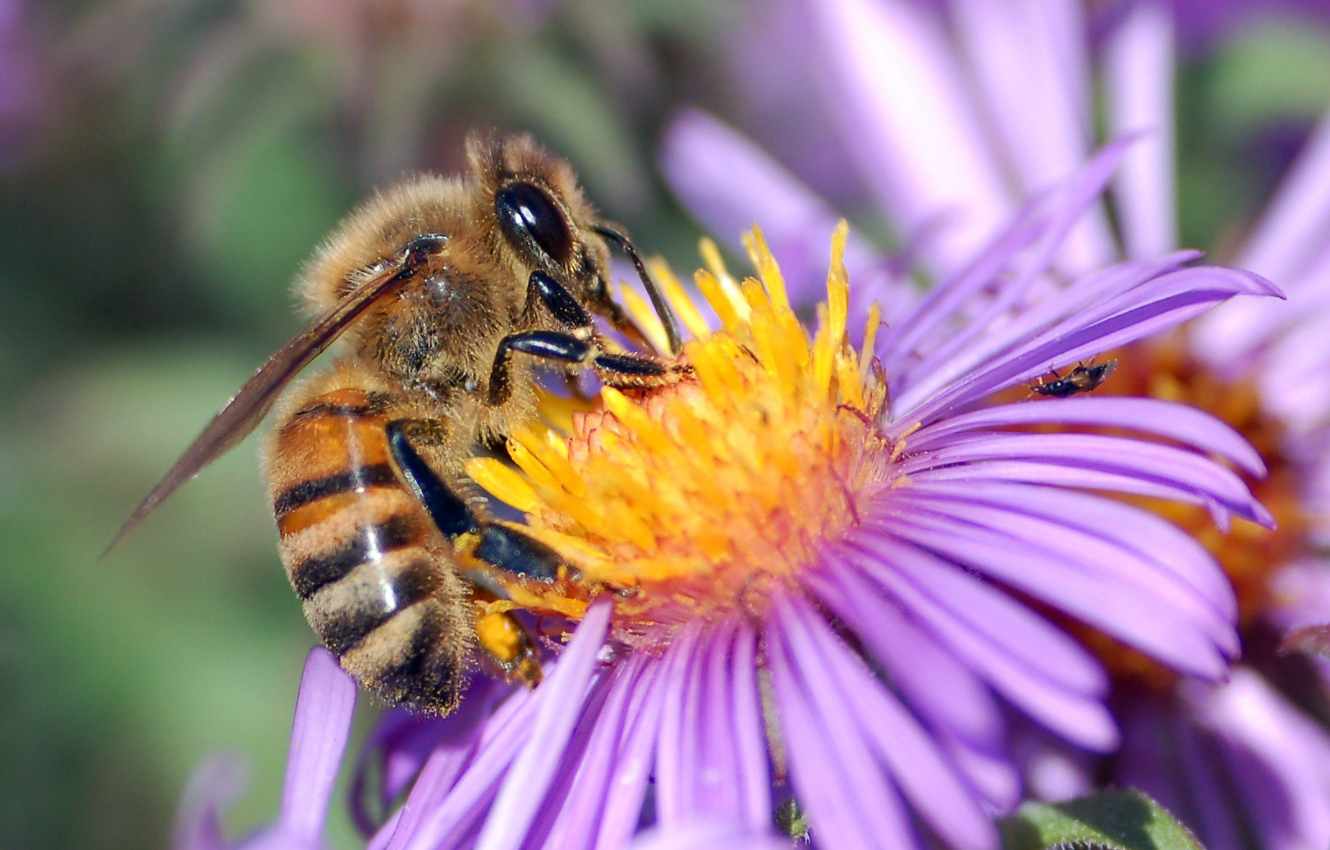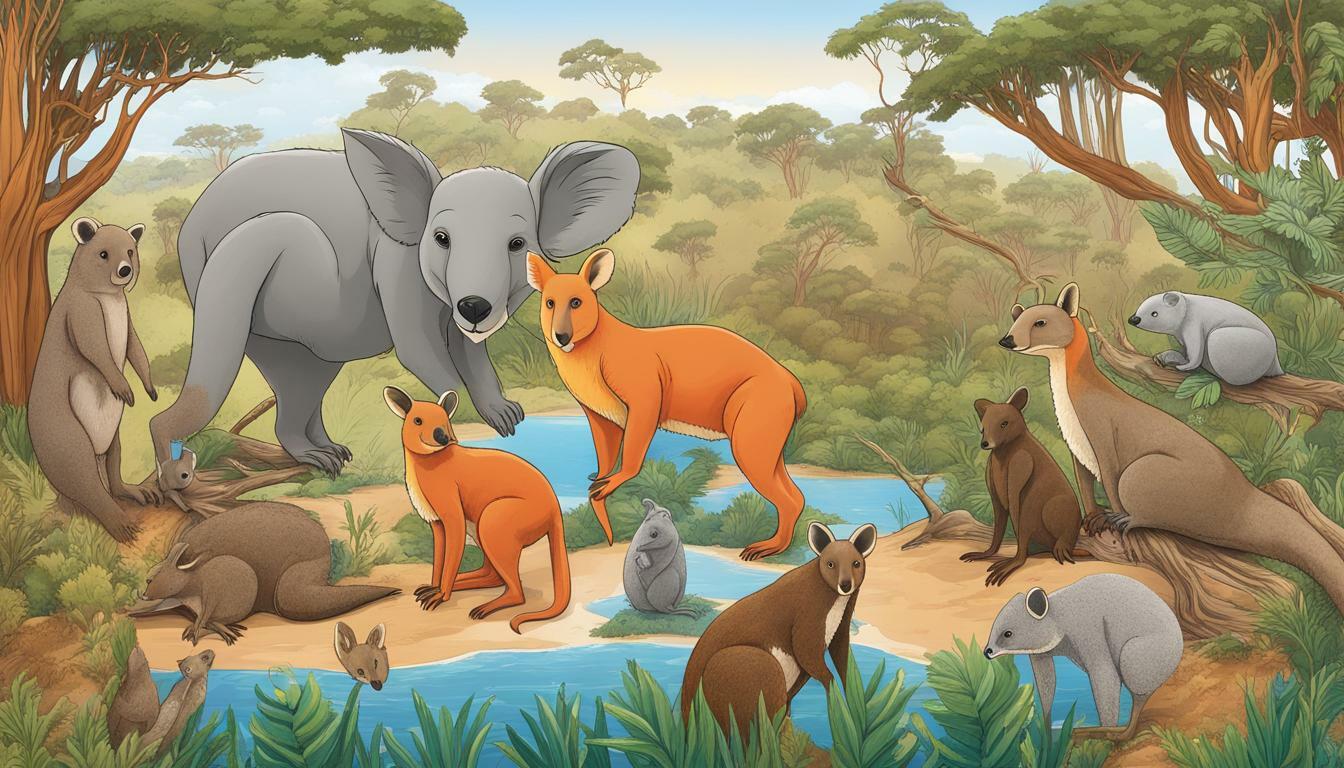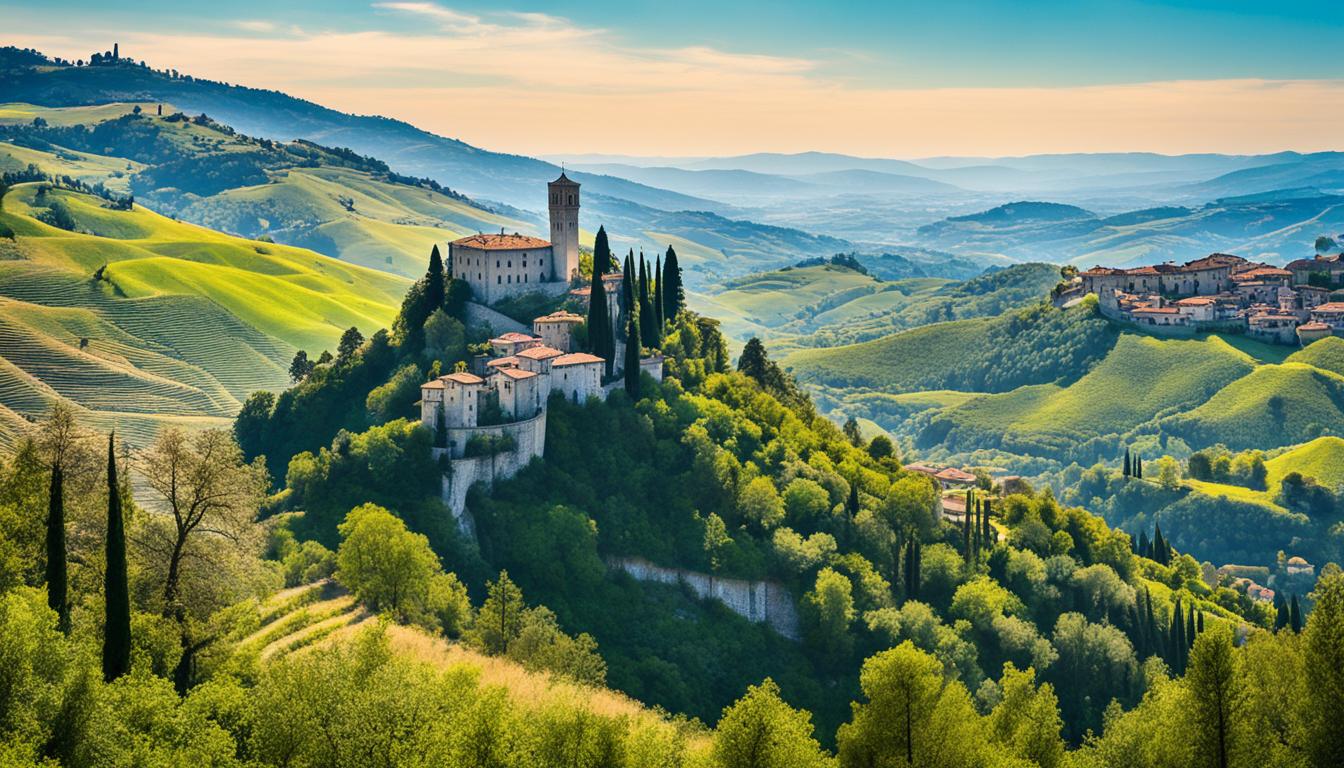San Marino Biodiversity: Animal and Plant Species and What Is Under Threat
San Marino, despite its small size, has a high level of biological, geological, and landscape diversity. Located on the Italian peninsula, it boasts small steep valleys, creeks, and limestone cliffs. The country is home to various vegetation types and a wide variety of flora and fauna.
Key Takeaways
- San Marino is known for its rich biodiversity and diverse ecosystems.
- The country’s unique geological and landscape features contribute to its ecological diversity.
- San Marino is home to various vegetation types, including woodlands dominated by oaks and other broadleaves.
- A wide range of wildlife, including amphibians, birds, mammals, and reptiles, can be found in San Marino.
- Conservation efforts are essential to protect and preserve the biodiversity of San Marino for future generations.
Geological and Landscape Diversity in San Marino
San Marino’s territory encompasses a multitude of geological and landscape features, contributing to its rich biodiversity. The country is characterized by small steep valleys, meandering creeks, and imposing limestone cliffs. These natural elements create a diverse and captivating scenery for both residents and visitors alike.
One prominent geological feature within San Marino is the Valmarecchia rock slabs. These rock formations give the land an indented and heterogeneous orography, which is enhanced by the presence of frequent landslides. This unique topography adds a touch of ruggedness and raw beauty to the landscape, attracting nature enthusiasts and geology aficionados.
Moreover, San Marino’s landscape diversity extends beyond its geological formations. The country boasts a variety of land use types, including woodlands, arable lands, orchards, vineyards, and olive groves. These different land uses contribute to the ecological diversity of the region, providing habitats for a wide range of plant and animal species.
Overall, the geological and landscape diversity in San Marino creates a captivating environment that supports a thriving ecosystem. It showcases the interconnectedness of geological processes and natural habitats, underscoring the importance of preserving and protecting the country’s biodiversity.
Vegetation Types and Flora in San Marino
San Marino showcases a diverse range of vegetation types, contributing to its rich biodiversity. The country’s woodlands are predominantly dominated by oaks and other broadleaved trees, such as Quercus pubescens and Fraxinus ornus. These majestic trees create a lush green canopy and provide a habitat for numerous species.
“The woodlands of San Marino are a sight to behold, with their towering oaks and vibrant undergrowth. It’s a true testament to the ecological diversity of the region.”
Shrublands and similar lands are also prevalent in San Marino, hosting a variety of plant species. The landscapes are adorned with plants like Crataegus monogyna, commonly known as hawthorn, and Cornus sanguinea, or dogwood. These shrubs add bursts of color to the natural surroundings and contribute to the overall vibrancy of the flora in San Marino.
The country’s flora is not only visually stunning but also essential for supporting and sustaining the diverse wildlife found in San Marino. The interplay between the vegetation types creates a harmonious ecosystem that allows for the survival and proliferation of various species, enriching the biodiversity of the region.
To illustrate the beauty and diversity of San Marino’s flora, here is an image showcasing the vibrant woodlands:

As evidenced by the image, the woodlands of San Marino are teeming with life, fostering a thriving ecosystem. The lush greenery, combined with the diverse vegetation types, creates a picturesque landscape that captivates both locals and visitors alike.
Fauna and Wildlife in San Marino
San Marino boasts a rich diversity of wildlife, including a wide range of amphibians, birds, mammals, and reptiles. The country is home to various species, such as the South European Nase (Chondrostoma genei), known for its distinctive appearance and habitat preferences. The presence of nesting birds also indicates the suitability of the environment for avian species. However, it is crucial to note that some of these species are currently endangered or critically endangered. This highlights the pressing need for comprehensive conservation efforts to protect and preserve the unique wildlife found in San Marino.

Conservation initiatives play a vital role in safeguarding the fauna and wildlife in San Marino. By implementing measures to mitigate threats and maintain suitable habitats, authorities can ensure the long-term survival of these remarkable creatures. Preserving the country’s biodiversity is not only essential for the ecological balance but also contributes to the aesthetic and educational value of San Marino’s natural heritage.
Threats to Biodiversity in San Marino
The biodiversity in San Marino faces several threats, including habitat loss and fragmentation due to urbanization and intensive land use. The alteration of ecosystems in running waters, caused by the dispersion of organic waste and modification of riverbeds, is also a significant threat. These factors have led to the endangerment and extinction of certain species and highlight the urgent need for conservation efforts.
Urbanization and intensive land use in San Marino pose significant threats to the country’s biodiversity. As the population grows and infrastructure expands, natural habitats are being destroyed and replaced with urban areas or agricultural land. This habitat loss disrupts the delicate balance of ecosystems, leading to the decline or disappearance of various plant and animal species. The destruction of habitats also results in the fragmentation of remaining natural areas, isolating populations and reducing genetic diversity.
“The urbanization and habitat loss in San Marino have had a detrimental impact on the biodiversity of the country. We have observed the decline of many native species and the loss of important ecological connections between habitats,” says Dr. Maria Rossi, a conservation biologist.
Another significant threat to biodiversity in San Marino is the alteration of ecosystems in running waters. The dispersion of organic waste, such as pollutants and excess nutrients, into rivers and streams disrupts the delicate balance of aquatic ecosystems. Additionally, the modification of riverbeds, such as damming or channelization, alters the natural flow of water, impacting the habitats of aquatic species and compromising their survival.
The consequences of these threats are already evident in San Marino’s biodiversity. Several species, including plants, insects, amphibians, and birds, have experienced population declines or even extinction. The loss of biodiversity not only impacts the natural heritage of the country but also has cascading effects on ecosystem functioning and human well-being.

Conservation Efforts in San Marino
San Marino recognizes the importance of preserving its unique biodiversity and has implemented various conservation measures to protect and conserve its natural heritage. These efforts aim to ensure the long-term sustainability of the country’s ecosystems and the species that depend on them.
“Conservation is at the heart of our commitment to environmental stewardship,” says Dr. Maria Rossi, director of the San Marino Naturalistic Centre. “We work tirelessly to safeguard the rich biodiversity that our country possesses.”
One of the key initiatives undertaken by San Marino is the establishment of protected areas throughout the country. These areas serve as havens for rare and endangered biological species, providing them with the necessary habitats to thrive. Critical habitat restoration projects are also carried out within these protected areas to promote the recovery of threatened species and enhance biodiversity.
The San Marino Naturalistic Centre plays a pivotal role in biodiversity conservation. As the scientific authority responsible for monitoring the natural aspects of the country, the centre conducts extensive research and studies to assess the state of the environment and biodiversity in San Marino. This valuable information informs the development of effective conservation strategies and helps guide decision-making processes.
In addition to research and monitoring, the San Marino Naturalistic Centre actively implements conservation measures. These include the implementation of habitat management plans, the promotion of sustainable land use practices, and the enforcement of regulations to prevent environmental degradation and habitat loss.
Collaboration with international organizations and experts further strengthens San Marino’s conservation efforts. Partnership initiatives focus on knowledge sharing, capacity building, and best practices in biodiversity conservation. By leveraging global expertise and resources, San Marino enhances its capabilities in protecting its unique flora and fauna.
Overall, San Marino’s commitment to biodiversity conservation and the establishment of protected areas demonstrate the country’s dedication to preserving its natural heritage for future generations.

National Biodiversity Strategy and Action Plan in San Marino
In San Marino, although there is no National Biodiversity Strategy and Action Plan in place, the country has implemented various conservation initiatives to protect its diverse ecosystem. The San Marino Agenda 21 Coordination takes the lead in organizing training programs, awareness-raising campaigns, and conferences focused on ecosystem protection, sustainable development, and climate change.
One of the specific plans implemented is the Agro-Environmental Plan, which aims to promote eco-friendly agricultural practices. This plan encourages farmers to adopt sustainable farming methods that minimize the negative impact on the environment while promoting the preservation of San Marino’s unique biodiversity.

Legislation and Monitoring in San Marino
San Marino recognizes the importance of protecting its diverse biodiversity and has implemented environmental legislation that aligns with European standards. This legislation aims to safeguard the environment and promote sustainable development within the country.
One of the key institutions responsible for monitoring San Marino’s biodiversity is the San Marino Naturalistic Centre. Through study and research activities, the centre gathers crucial data on the state of the country’s flora, fauna, and ecosystems. By collaborating with other organizations and experts, they are able to analyze the presence of exotic species and monitor the effects of climate change on San Marino’s biodiversity.
Monitoring and research play a vital role in understanding the current state of biodiversity in San Marino and guiding conservation efforts. By tracking changes and trends over time, researchers can develop strategies to protect and preserve the unique flora and fauna of the country.
To illustrate the importance of monitoring, the table below showcases some of the key findings from recent studies conducted by the San Marino Naturalistic Centre:
| Study | Key Findings |
|---|---|
| Effects of Urbanization on Biodiversity | – Increased habitat fragmentation – Decline in native species populations – Encroachment of non-native species |
| Climate Change Impacts on Birds | – Shift in breeding and migration patterns – Decreased reproductive success – Range expansion for certain bird species |
| Invasive Species Monitoring | – Identification and mapping of invasive species – Assessment of their impact on native ecosystems – Implementation of control measures |

The image above showcases the diverse flora and fauna that San Marino aims to protect through its environmental legislation and monitoring efforts.
By actively monitoring and analyzing changes in biodiversity, San Marino can better understand the impact of human activities and take appropriate conservation measures to ensure the long-term survival of its unique ecosystems.
Forest Cover and Land Use in San Marino
In San Marino, the forest cover is limited, with a significant portion of the territory being urban or used for agricultural purposes. The country boasts woodlands that are predominantly composed of oaks and other broadleaved trees, contributing to the overall biodiversity of the region.
However, there is currently no specific data available on the forest area or the percentage of forest cover in San Marino. This lack of information makes it challenging to assess the exact extent of the forested areas within the country.
Despite the limited forest cover, San Marino’s urban and agricultural landscapes still have important roles to play in terms of land use. The urban areas provide habitats for various species and contribute to the overall ecological diversity of the country. Likewise, agricultural activities, such as orchards, vineyards, and olive groves, contribute to the livelihoods of the local population and the preservation of traditional farming practices.
It is essential to strike a balance between land use for development and the preservation of natural habitats to ensure the continued sustainability of San Marino’s biodiversity.

The image above provides a visual representation of the forested areas in San Marino, highlighting the importance of preserving the existing woodlands and promoting sustainable land use practices.
Economic Impact and Sustainable Development in San Marino
The tourism sector plays a significant role in San Marino’s economy, contributing to the country’s GDP. With its rich biodiversity, San Marino strives for sustainable development that balances economic growth with the preservation of its natural heritage. The country recognizes the importance of protecting and conserving its diverse flora and fauna for the benefit of present and future generations.
Conservation efforts are essential in promoting sustainable development and safeguarding San Marino’s biodiversity. The preservation of natural habitats and the protection of endangered species are key priorities in ensuring the long-term viability of ecological systems. Through awareness-raising initiatives and educational programs, San Marino aims to engage both residents and visitors in sustainable practices that minimize the negative environmental impacts associated with tourism.
Developing environmentally-friendly tourism practices not only helps protect the delicate ecosystems of San Marino but also enhances the overall visitor experience. Sustainable tourism initiatives such as eco-friendly accommodations, responsible wildlife viewing, and promoting local and organic products provide economic opportunities while minimizing the ecological footprint.
By integrating sustainable development principles into its tourism industry, San Marino can strike a balance between economic growth and the preservation of its natural resources. This approach not only safeguards the country’s biodiversity but also contributes to the long-term economic stability and resilience of the nation.
| Positive Impacts of Biodiversity | Negative Impacts of Biodiversity Loss |
|---|---|
| Enhanced visitor experiences through nature-based tourism | Loss of unique wildlife species and natural habitats |
| Economic opportunities through sustainable tourism practices | Decreased attractiveness for tourists seeking natural destinations |
| Preservation of ecosystems and their valuable services | Disruption of ecological balance and potential collapse of ecosystems |
| Improved resilience to environmental changes | Reduced availability of natural resources for future generations |
Conclusion
San Marino boasts a remarkable biodiversity, highlighted by its diverse geological and landscape features, rich vegetation types, and abundant flora and fauna. However, this precious biodiversity is currently under threat due to urbanization, habitat loss, fragmentation, and the alteration of ecosystems. Protecting and preserving San Marino’s biodiversity is of utmost importance and requires dedicated conservation efforts and sustainable development initiatives.
By implementing measures to mitigate habitat loss and fragmentation and promoting environmental conservation, San Marino can safeguard its unique biodiversity for future generations. The establishment of protected areas, such as the San Marino Naturalistic Centre, and the development of a National Biodiversity Strategy and Action Plan will contribute to the preservation of endangered species and the maintenance of healthy ecosystems.
Conservation efforts should be coupled with sustainable development practices to strike a balance between economic growth and ecosystem preservation. San Marino’s commitment to sustainable tourism and eco-friendly agriculture showcases its dedication towards achieving this delicate equilibrium and ensuring the long-term viability of its natural heritage.
FAQ
What is the biodiversity like in San Marino?
San Marino has a high level of biological, geological, and landscape diversity. It is home to various vegetation types and a wide variety of flora and fauna.
What are the threats to biodiversity in San Marino?
The biodiversity in San Marino is under threat from factors such as urbanization, habitat loss, fragmentation, and alteration of ecosystems in running waters.
What conservation efforts are being made in San Marino?
San Marino has established protected areas for the safeguard of rare biological species and conducts studies and monitoring on the state of the environment and biodiversity.
Does San Marino have a National Biodiversity Strategy and Action Plan?
San Marino has not prepared a National Biodiversity Strategy and Action Plan, but it has established the San Marino Agenda 21 Coordination for ecosystem protection and sustainable development.
How is biodiversity monitored in San Marino?
The San Marino Naturalistic Centre is responsible for monitoring the country’s biodiversity through study and research activities, in collaboration with other organizations and experts.
What is the forest cover like in San Marino?
San Marino has limited forest cover, with much of its territory being urban or agricultural. There is no specific data on the forest area or forest cover percentage in San Marino.
How does tourism impact biodiversity in San Marino?
The tourism sector is a significant contributor to San Marino’s GDP, and the country strives for sustainable development that does not threaten its natural heritage.








